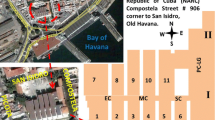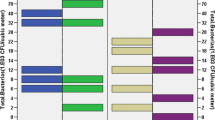Abstract
The objectives of this study were to evaluate the microbial prevalence inside six repositories of the National Archive of the Republic of Cuba in 2 months of the year and to examine some of the physiological features of fungi isolated in order to evaluate their potential for biodeterioration. The microbiological sampling was conducted in February and September using a slit impactor as air sampler. Appropriate selective culture media were used to isolate fungi and bacteria. Temperature and relative humidity were measured during the samplings. The cellulolytic activity and the production of acids and pigments of the fungi isolated were qualitatively determined. Total viable microbiota and bacteria concentrations were greater in February while the fungal concentration was higher in September. Aspergillus, Cladosporium, Penicillium, Curvularia and Alternaria were the predominant fungal genera in February while Cladosporium prevailed in September, although Fusarium, Mucor and Neurospora genera were also isolated in this month. The fungi isolated were capable of degrading cellulose and excreting pigments and acids. The Gram-positive bacteria group prevailed in the air and Corynebacterium, Streptomyces, Bacillus, Streptococcus, Staphylococcus, Enterobacter and Serratia were some of the genera identified.




Similar content being viewed by others
References
Aira, M. J., Rojas, T. I., & Jato, V. (2002). Fungi associated with three houses in Havana (Cuba). Grana, 41, 114–118.
Aspergillus Image Bank. (2006). Species images of Aspergillus. http://www.aspergillus.man.ac.uk/index.html. Accessed September 20, 2007.
Barnett, H. L., & Hunter, B. B. (1987). Illustrated genera of imperfect fungi (3rd ed.). Minneapolis: Burgess.
Baxter, C. S., Wey, H. E., & Burg, W. E. (1981). Prospective analysis of the potential risk associated with inhalation of aflatoxin-contaminated grain dusts. Food Cosmetics Toxicology, 19, 763–769.
Borrego, S., Pons, V., & Perdomo, I. (2008). La contaminación microbiana del aire en dos depósitos del Archivo Nacional de la República de Cuba. Revista CENIC Ciencias Biológicas, 39, 63–69.
Borrego, S., Guiamet, P., Gómez de Saravia, S., Battistoni, P., Garcia, M., Lavin, P., et al. (2010a). The quality of air at archives and the biodeterioration of photographs. International Biodeterioration and Biodegradation, 64, 139–145.
Borrego, S., Perdomo, I., Guiamet, P., & Gómez de Saravia, S. (2010b). Estudio de la concentración microbiana en el aire de depósitos del Archivo Nacional de Cuba. AUGMDOMUS, 1, 114–133.
Burge, H., & Gallup, D. (2005). Endotoxins. The Environmental Reporter, 3(3). http://www.emlab.com/s/sampling/env-report-03-2005.html. Accessed May 27, 2005.
Cappitelli, F., Fermo, P., Vecchi, R., Piazzalunga, A., Valli, G., Zanardini, E., et al. (2009). Chemical-physical and microbiological measurements for indoor air quality assessment at the Ca’Granada Historical Archive, Milan (Italy). Water, Air, and Soil pollution, 201, 109–120.
Cooley, J. D., Wong, W. C., Jumper, C. A., & Straus, D. C. (1999). Cellular and humoral responses in an animal model inhaling Penicillium chrysogenum spores. In E. Johanning (Ed.), Bioaerosols, fungi and mycotoxins. Proceeding of the third international conference on fungi, micotoxyns and bioaerosols (pp. 403–410). New York: Saratoga Springs.
Côté, J., Chan, H., Brochu, G., & Chan-Yeung, M. (1991). Occupational asthma caused by exposure to neurospora in a plywood factory worker. British Journal of Industrial Medicine, 48, 279–282.
de la Rosa, M. C., Mosso, M. A., & Ullán, C. (2002). El aire: Habitat y medio de transmisión de microorganismos. Observatorio Medioambiental, 5, 375–402.
Deshpande, J., & Gangawane, L. V. (1997). Microorganism collected during a solar eclipse in India. Aerobiologia, 13, 289–294.
Dopazo, A., Aira, M. J., Armisén, M., & Vidal, C. (2002). Relationship of clinical and aerobiological data in the NW of Spain. Allergology and Immunopathology, 30, 74–78.
Ellis, M. B. (1971). Dematiaceous hyphomycetes. Kew, England: Commonwealth Mycological Institute.
Ellis, M. B. (1976). More dematiaceous hyphomycetes. Kew, England: Commonwealth Mycological Institute.
EMLab P & K. (2010). Mucor. Fungal Library, TestAmerica Environmental Microbiology Laboratory. http://www.emlab.com/app/fungi/Fungi.po. Accessed May 25, 2010.
FEDECAI-01. (2007). Programa de certificación de calidad ambiental en interiores. Calidad ambiental en interiores: Criterios de muestreo (pp. 4–6). Federación Española de Empresas de Calidad Ambiental Interior (FEDECAI).
Fernández, F. (2005). Fungus of the month: Penicillium. The Environmental Reporter, 3(1). http://www.emlab.com/s/sampling/env-report-01-2005.html. Accessed February 27, 2005.
Florian, M.-L. E. (2004). Fungal facts. Solving fungal problems in heritage collections. London, UK: Archetype.
Gautan, A. K., Sharma, S., Avasthi, S., & Bhadauria, R. (2011). Diversity, pathogenicity and toxicology of A. niger: An important spoilage fungi. Research Journal of Microbiology, 6, 270–280.
Gómez, B., Rojas, T. I., & Casadesús, L. (1989). Determinación de la capacidad celulolítica de hongos termófilos aislados en Cuba. Revista Biología de la Universidad de la Habana, 3, 39–42.
Green, C. F., Scarpino, P. V., & Gibbs, S. G. (2003). Assessment and modeling of indoor fungal and bacterial bioaerosol concentrations. Aerobiologia, 19, 159–169.
Guiamet, P. S., Borrego, S., Lavin, P., Perdomo, I., & Gómez de Saravia, S. (2011). Biofouling and biodeterioration in material stored at historical archive of the museum of La Plata, Argentine and at the National Archive of the Republic of Cuba. Colloids and Surfaces B: Biointerfaces, 85, 229–234.
Hedayati, M. T., Pasqualotto, A. C., Warn, P. A., Bowyer, P., & Denning, D. W. (2007). Aspergillus flavus: Human pathogen, allergen and mycotoxin producer. Microbiology, 153, 1677–1692.
Holmberg, K. (1987). Indoor mould exposure and health effects. In B. Seifert, H. Esdom, M. Fischer, H. Rüden, & J. Wegner (Eds.), 4th International conference of indoor air quality and climate (Vol. 1, pp. 637–642). Berlin: Institute of Water, Soil, and Air Hygiene.
Holt, J. G. (Ed.). (1984). Bergey’s manual of systematic bacteriology (Vol. 1). Baltimore, London: Williams & Wilkins.
Holt, J. G. (Ed.). (1986). Bergey’s manual of systematic bacteriology (Vol. 2). Baltimore, London: Williams & Wilkins.
Klich, M. A., & Pitt, J. I. (1994). A laboratory guide to common Aspergillus species and their teleomorphs. North Ryde, Australia: CSIRO, Division of Food Processing.
Madrigal, B., Arenal, J. J., Torres, A., Peñarrubia, M. J., Vara, A., Ruiz, M., et al. (2008). Mucormicosis yeyunal en paciente con linfoma de Hodgkin. Revista Española de Enfermedades Digestivas, 100, 507–510.
Maggi, O., Persiani, A. M., Gallo, F., Valenti, P., & Pasquariello, G. (2000). Airborne fungal spores in dust present in archives: Proposal for a detection method, new for archival materials. Aerobiologia, 16, 429–434.
Mesquita, N., Portugal, A., Videira, S., Rodríguez-Echeverría, S., Bandeira, A. M. L., Santos, M. J. A., et al. (2009). Fungal diversity in ancient documents. A case study on Archive of the University of Coimbra. International Biodeterioration and Biodegradation, 63, 626–629.
Miller, V., Sasala, K., Hogan, M., & Roberts, L. (2004). Health effect of project SHAD biological agent: Bacillus globigii. Maryland, USA: National Academies, The Center for Research Information. Contract no. IOM-2794-04-001. http://www.iom.edu/~/media/Files/Report%20Files/2007/Long-Term-Health-Effects-of-Participation-in-Project-SHAD-Shipboard-Hazard-and-Defense/CALCOFLUOR.pdf. Accessed November 12, 2007.
Nevalainen, A., & Morawaska, L. (2009). Biological agents in indoor environments. Assessment of health risks. Work conducted by a WHO Expert Group between 2000 and 2003. http://www.ilaqh.qut.edu.au/Misc/BIOLOGICAL_AGENTS_2009.pdf. Accessed September 4, 2009.
Nielsen, K. F. (2003). Mycotoxin production by indoor molds. Fungal Genetics and Biology, 39, 103–117.
Pasenen, A., Kasanen, J., Rautiala, S., Ikaheimo, M., Rantamaki, J., Kaariainen, H., et al. (2000). Fungal growth and survival in building materials under fluctuating moisture and temperature conditions. International Biodeterioration and Biodegradation, 46, 117–127.
Person, A. K., Chudgar, S. M., Norton, B. L., Tong, B. C., & Stout, J. E. (2010). Aspergillus niger: An unusual cause of invasive pulmonary aspergillosis. Journal of Medical Microbiology, 59, 834–838.
Pinzari, F., Paquariello, G., & De Mico, A. (2006). Biodeterioration of paper: A SEM study of fungal spoilage reproduced under controlled conditions. Macromolecular Symposia, 238, 57–66.
Pitt, J. I. (2000). A laboratory guide to common Penicillium species. Color appendix. Third edition published by Food Science Australia. http://www.dehs.umn.edu/iaq_fib_fg_gloss_penicilliumsp.htm. Accessed October 26, 2007.
Radler de Aquino, F., & de Góes, L. F. (2000). Guidelines for indoor air quality in offices in Brazil. Proceedings of Healthy Buildings, 4, 549–553.
Ramírez, P., & Coha, J. M. (2003). Enzymatic degradation of cellulose for thermophilic actinomycete: Isolation, characterization and cellulolytic activity determination. Revista Peruana de Biologia, 10, 67–77.
Rintala, H., Pitkäranta, M., Toivola, M., Paulin, L., & Nevalainen, A. (2008). Diversity and seasonal dynamics of bacterial community in indoor environment. BMC Microbiology, 8, 56. doi:10.1186/1471-2180-8-56.
Rojas, T. I., Martínez, E., Gómez, Y., & Alvarado, Y. (2002). Airborne spores of Aspergillus species in cultural institutions al Havana university. Grana, 41, 190–193.
Rojas, T. I., Martínez, E., Aira, M. J., & Almaguer, M. (2008). Aeromicota de ambientes internos: Comparación de métodos de muestreo. Boletín Micológico, 23, 67–73.
Sabariego, S., Díaz de la Guardia, C., & Sánchez, F. A. (2004). Estudio aerobiológico de los conidios de Alternaria y Cladosporium en la atmósfera de la ciudad de Almería (SE de España). Revista Iberoamerica de Micología, 21, 121–127.
Scott, J., Untereiner, W. A., Wong, B., Straus, N. A., & Malloch, D. (2004). Genotypic variation in Penicillium chrysogenun from indoor environments. Mycologia, 96, 1095–1105.
Singh, J. (2005). Toxic moulds and indoor air quality. Indoor and Built Environment, 14, 229–234.
Smith, G. (1980). Ecology and field biology (2nd ed.). New York: Harper & Row.
Storey, E., Dangman, K. H., Schenck, P., DeBernardo, R. L., Yang, C. S., Bracker, A., et al. (2004). Guidance for clinicians on the recognition and management of health effects related to mold exposure and moisture indoors. Farmington, USA: University of Connecticut Health Center, Center for Indoor Environments and Health. http://www.structuretec.com/pdfs/AirQuality.pdf. Accessed April 4, 2006.
Toivola, M., Alm, S., Reponen, T., Kolari, S., & Nevalainen, A. (2002). Personal exposure and microenvironmental concentration of particles and bioaerosols. Journal of Environmental Monitoring, 4, 166–174.
Valentín, N. (2010). Microorganisms in museum collections. COALITION, (19), 2–5.
Valentín, N., Vaillant, M., & Guerrero, H. (1997). Programa de control integrado de plagas en bienes culturales de países de clima mediterráneo y tropical. Apoyo, 7, 13–14.
Walker, A. (2003). Basic preservation guidelines for library and archive collections. National Preservation Office, NPO Preservation Guidance, British Library. http://www.bl.uk/b1pac/pdf/basic.pdf. Accessed February 9, 2006.
Acknowledgments
The authors thank Dr. Teresa Rojas for providing the Chirana Aeroscope to carry out the study. We also thank B.A. Enrique Vergés Gorostiza for his valuable revision and edition of the translation to the English language.
Author information
Authors and Affiliations
Corresponding author
Rights and permissions
About this article
Cite this article
Borrego, S., Perdomo, I. Aerobiological investigations inside repositories of the National Archive of the Republic of Cuba. Aerobiologia 28, 303–316 (2012). https://doi.org/10.1007/s10453-011-9235-x
Received:
Accepted:
Published:
Issue Date:
DOI: https://doi.org/10.1007/s10453-011-9235-x




